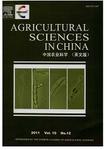Cloning and Sequence Analysis of Disease Resistance Gene Analogues from Three Wild Rice Species in Yunnan
Cloning and Sequence Analysis of Disease Resistance Gene Analogues from Three Wild Rice Species in Yunnan作者机构:BiotechnologyResearchInstituteYunnanAcademyofAgriculturalSciencesKunming650223P.R.China BiotechnologyDepartmentYunnanUniversityKunming650091P.R.China
出 版 物:《Agricultural Sciences in China》 (中国农业科学(英文版))
年 卷 期:2003年第2卷第3期
页 面:265-272页
主 题:Wild rice Disease-resistance gene Nucleotide-binding site ( NBS) Leucine-rich repeat (LRR) Serine/threonine protein kinase(STK) Analogues
摘 要:Two sets of degenerate oligonucleotide primers were designed according to amino acid conserved regions of reported plant disease resistance genes which encode proteins that contain nucleotide-binding site and leucine-rich repeats(NBS-LRR), and the plant disease resistance genes which encode serine/threonine protein kinase(STK). By polymerase chain reaction(PCR), disease resistance gene analogues have been amplified from three wild rice species in Yunnan Province, China. The DIN A fragments from amplification have been cloned into the pGEM-T vector respectively. Sequencing of the DNA fragments indicated that 7 classes, 2 classes and 6 classes NBS-LRR disease resistance gene analogues from Oryza rufipogon Griff. , Oryza officinalis Wall. , and Oryza meyeriana Baill. were obtained respectively. The two representative fragments of TO12 from Oryza officinalis Wall, and TR19 from Oryza rufipogon Griff, belong to the same class and homology of their sequences are 100%. The result shows that the sequences of the same class disease resistance gene analogues have no difference among different species of wild rice. 5 classes STK disease resistance gene analogues were also obtained among which 4 classes from Oryza rufipogon Griff. , 1 class from Oryza officinalis Wall. By comparison analysis of amino acid sequences. we found that the obtained disease resistance gene analogues have very low identity(low to 25%) with the reported disease resistance gene L6, N, Bs2, Prf, Pto, Lr10 and Xa21 etc. The finding suggests that the obtained disease resistance gene analogues are analogues of putative disease resistance genes that have not been isolated so far.



